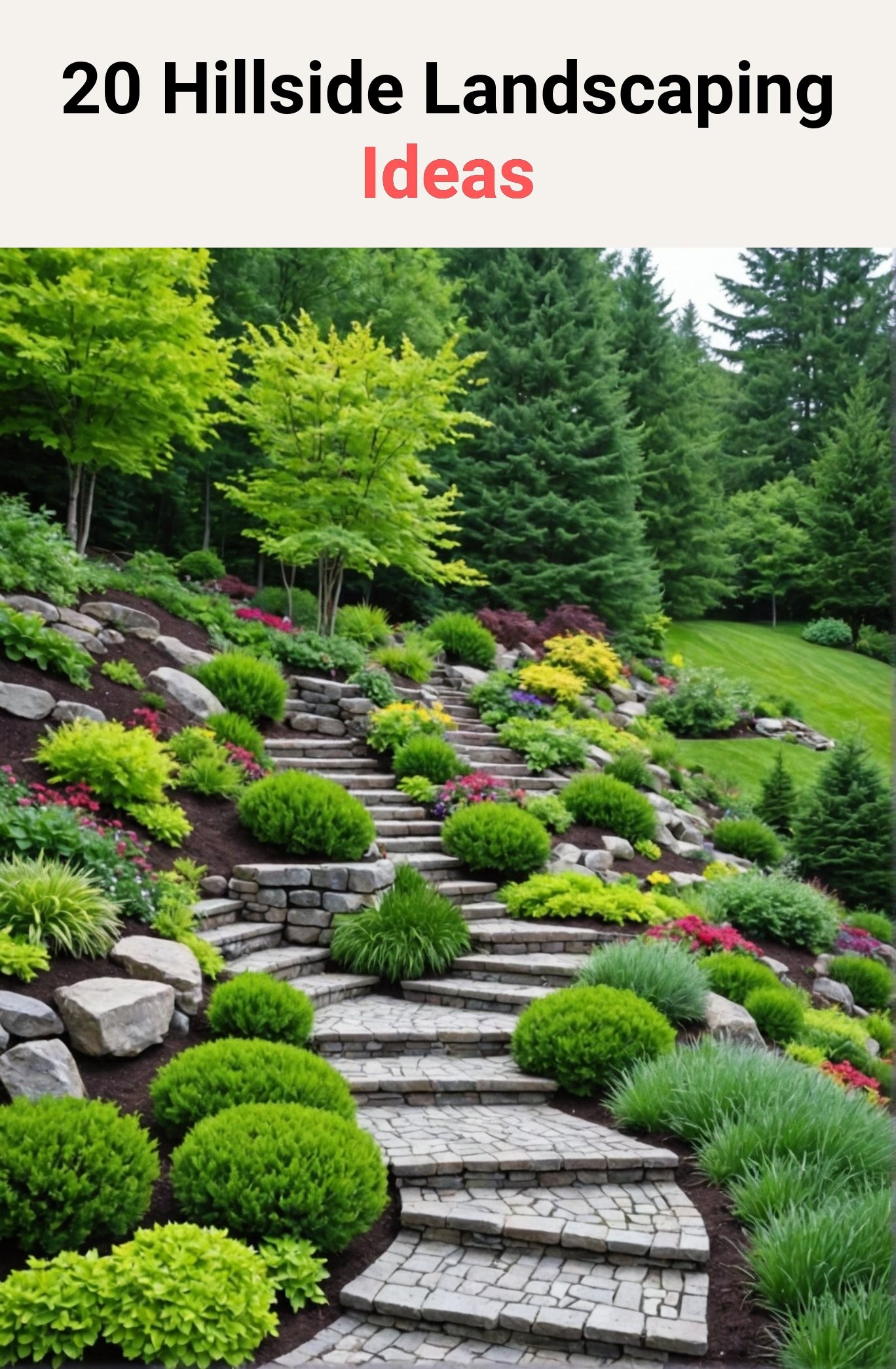Beautiful Plants For Your Interior
Beautiful Plants For Your Interior
Transform your sloping outdoor space into a stunning hillside landscape with these 20 inspiring ideas.
From tiered gardens and retaining walls to hillside water features and native plant landscaping, discover the perfect solution to tame your uneven terrain and create a beautiful, functional outdoor oasis.
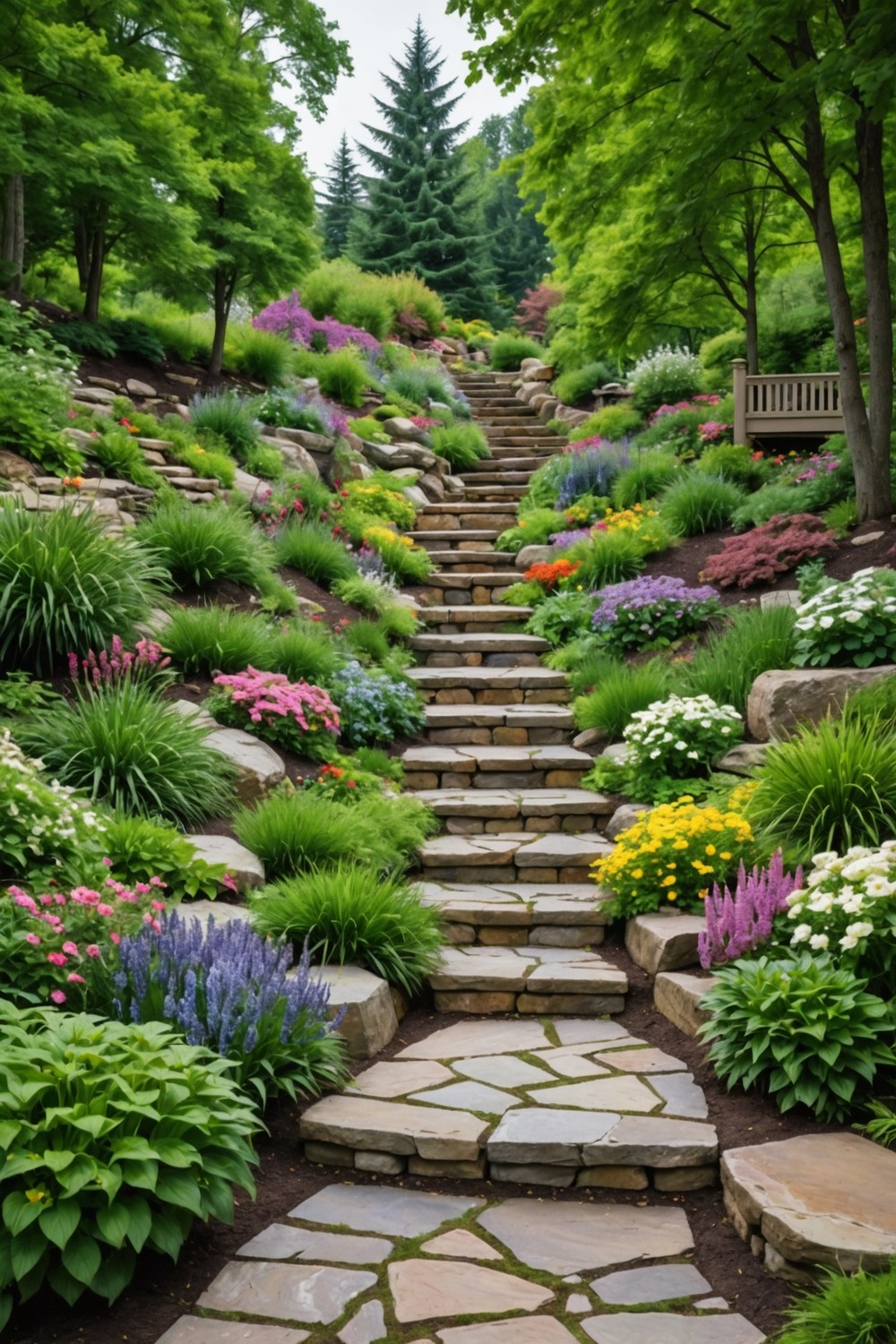
Tiered gardens are a brilliant solution for hillside landscaping as they allow you to create visually appealing levels and sections, while also tackling the issue of erosion and drainage.
By breaking up the slope into smaller, manageable areas, you can create a series of beautiful gardens, each with its own unique character and charm.
This approach also enables you to incorporate a variety of plants and features, from flowering perennials to small water features, adding depth and interest to your hillside landscape.
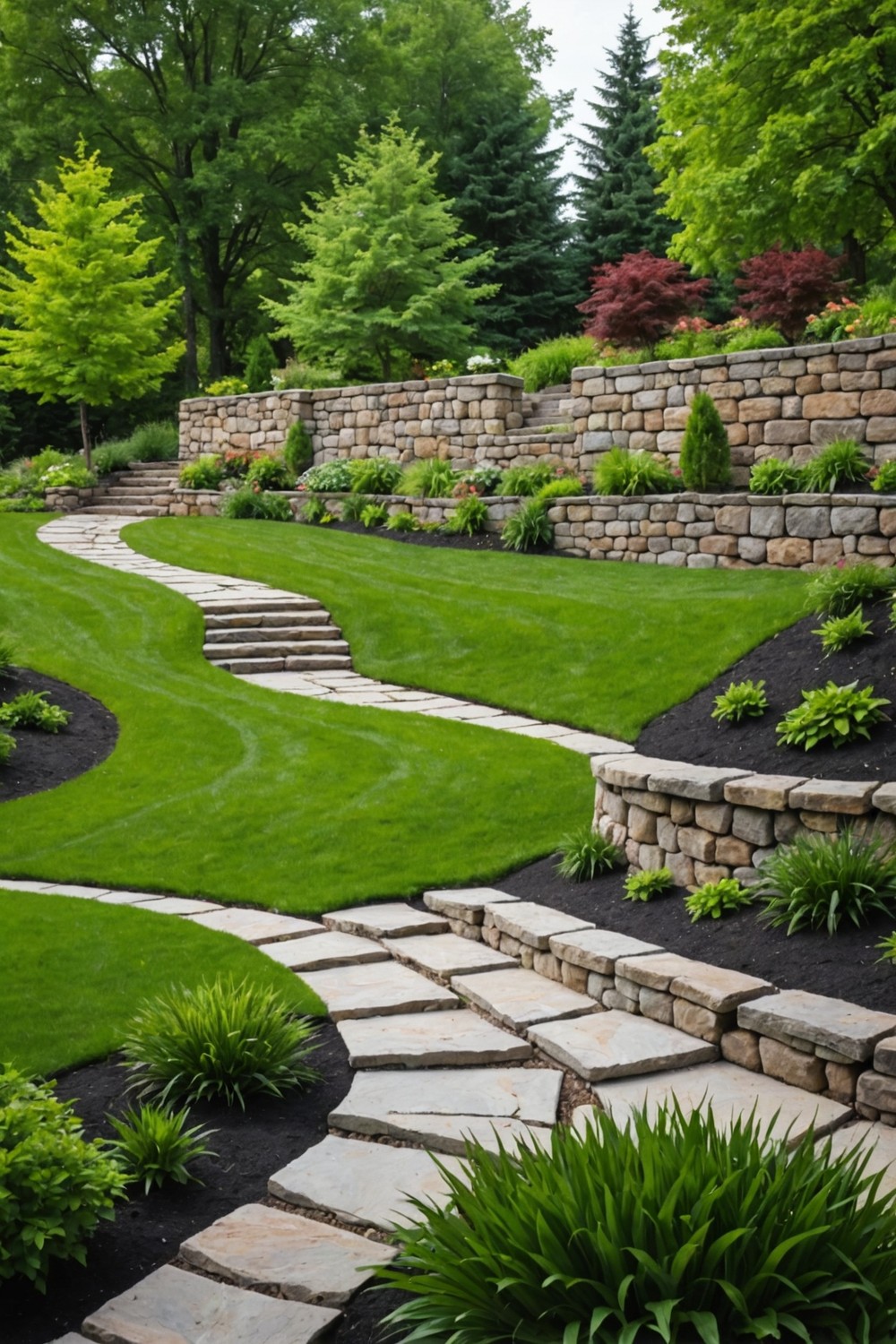
Retaining walls are a necessary solution for erosion control on hillside properties.
They prevent soil erosion by holding back the soil and allowing water to drain slowly, reducing the risk of landslides and mudslides.
These walls can be constructed from various materials such as concrete, stone, or timber, and can be designed to blend seamlessly into the surrounding landscape.
By installing a retaining wall, you can create a stable and functional outdoor space, perfect for landscaping and gardening.
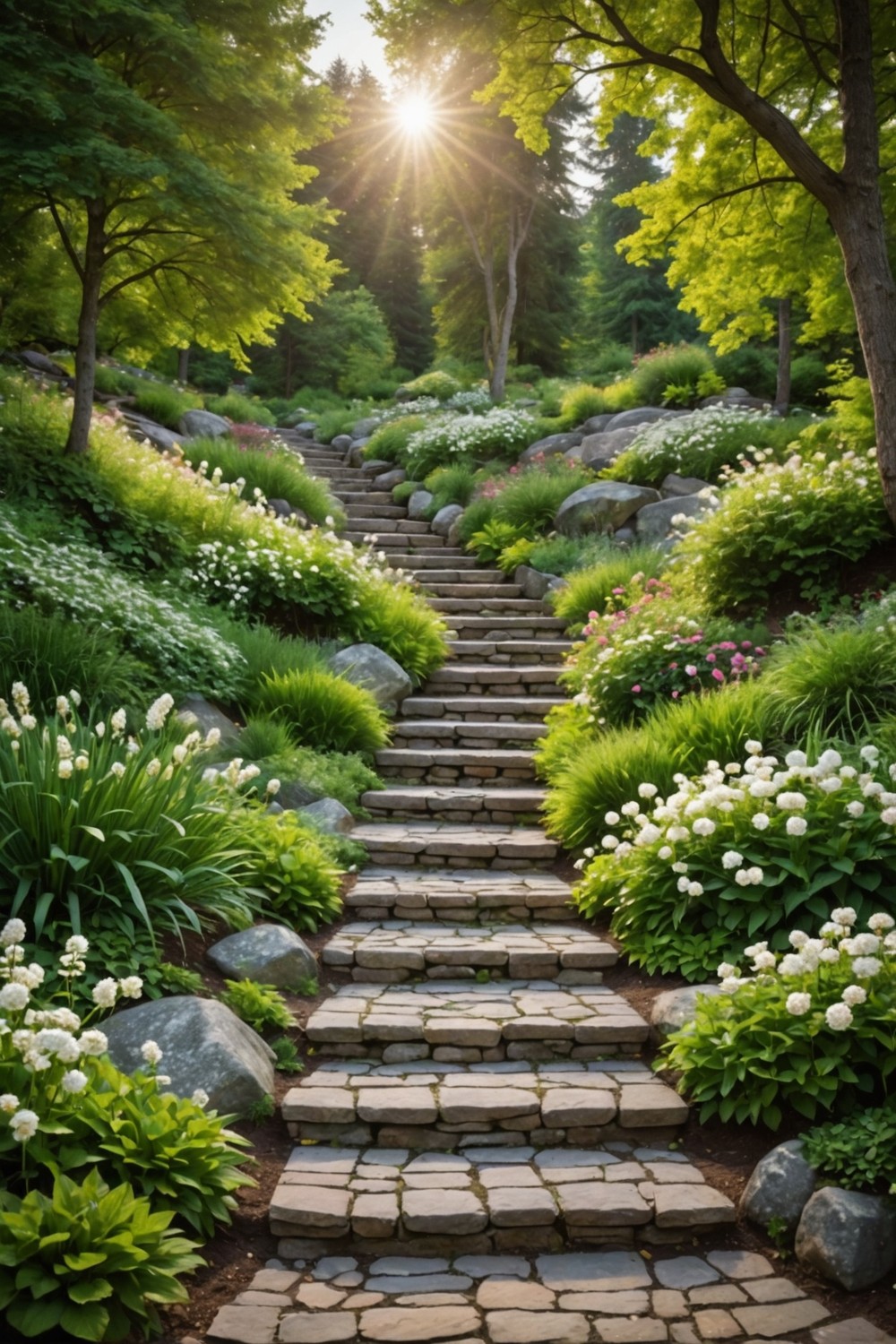
For navigating a hilly landscape, incorporating stairways and pathways is essential.
They provide a safe and accessible route for people to move around while also adding visual appeal to the surroundings.
A well-designed stairway can make a significant difference in breaking up a steep slope, making it easier to traverse.
Meanwhile, meandering pathways create a sense of journey and exploration, encouraging visitors to slow down and appreciate the scenery.
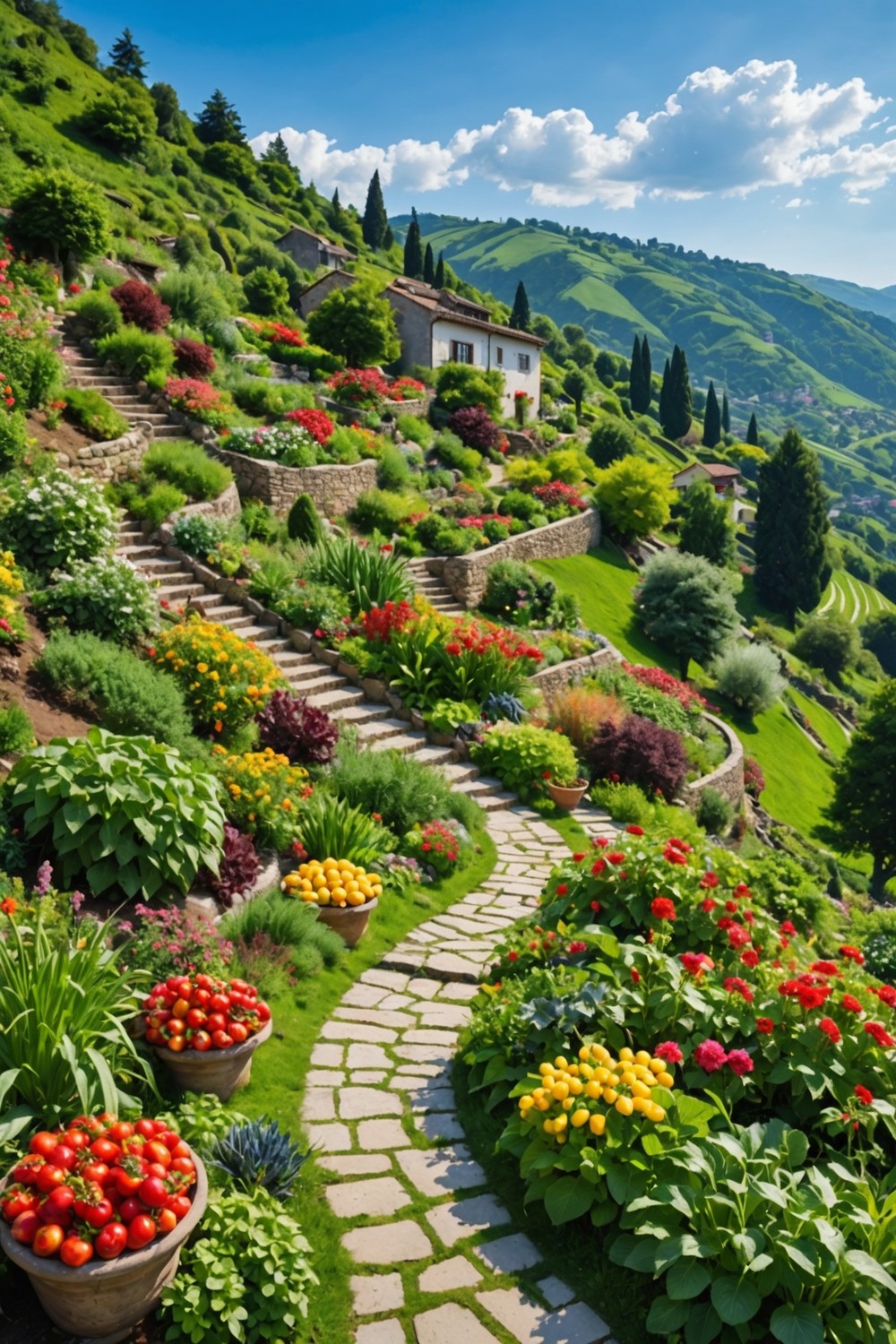
A hillside vegetable garden is an innovative way to transform a sloping landscape into a productive haven.
By creating terraced beds or raised planters, you can make the most of your hillside space and grow a bounty of fresh fruits and veggies.
This approach not only enhances the aesthetic appeal of your yard but also increases its functionality.
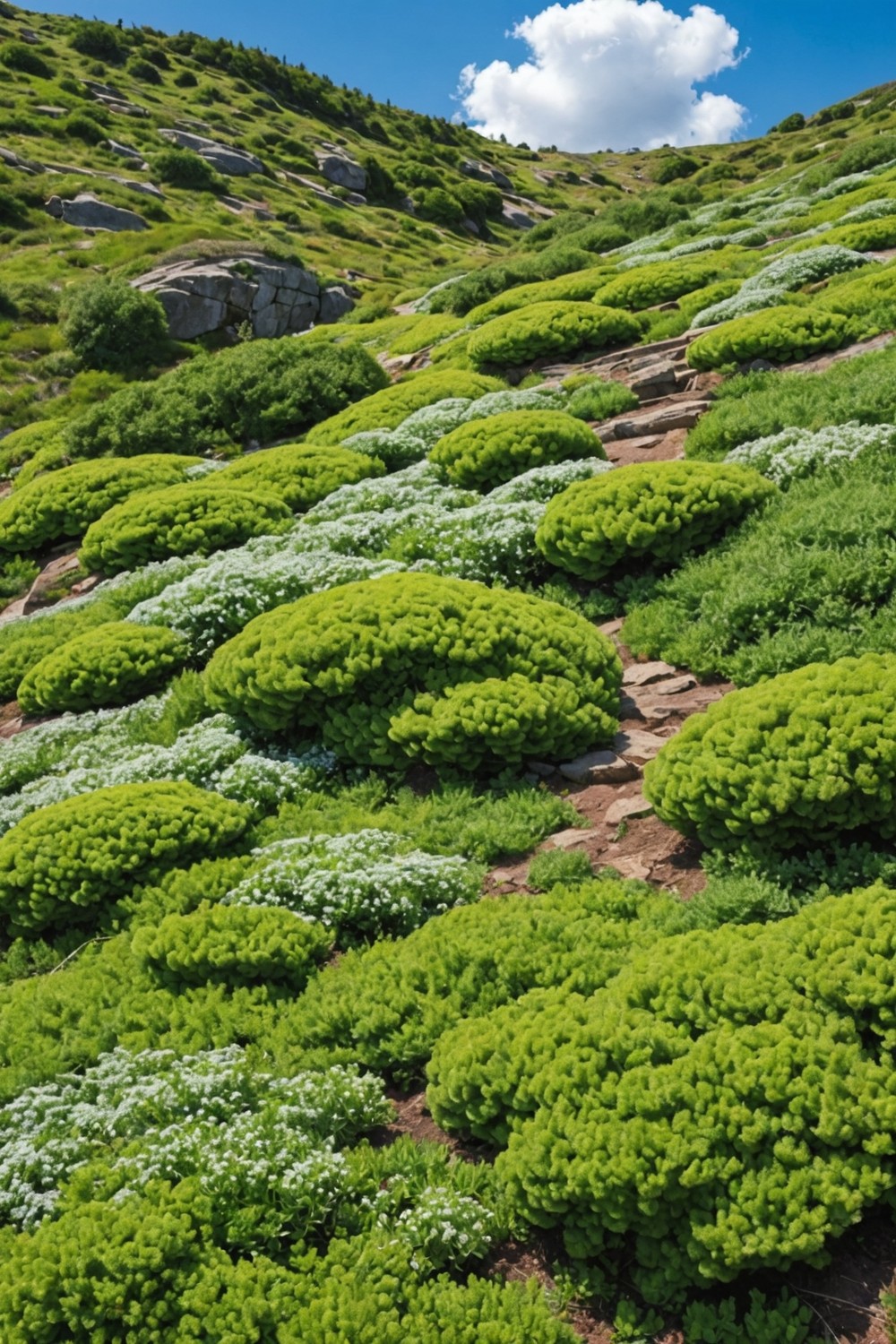
Slope-stabilizing ground covers are a great solution for hillside landscaping as they help to prevent erosion and retain soil.
These ground covers have deep roots that dig into the soil, anchoring it in place, and their dense foliage covers the surface, reducing rain runoff.
Some popular options include creeping juniper, sedum, and vinca minor, which can thrive in poor soil and withstand drought.
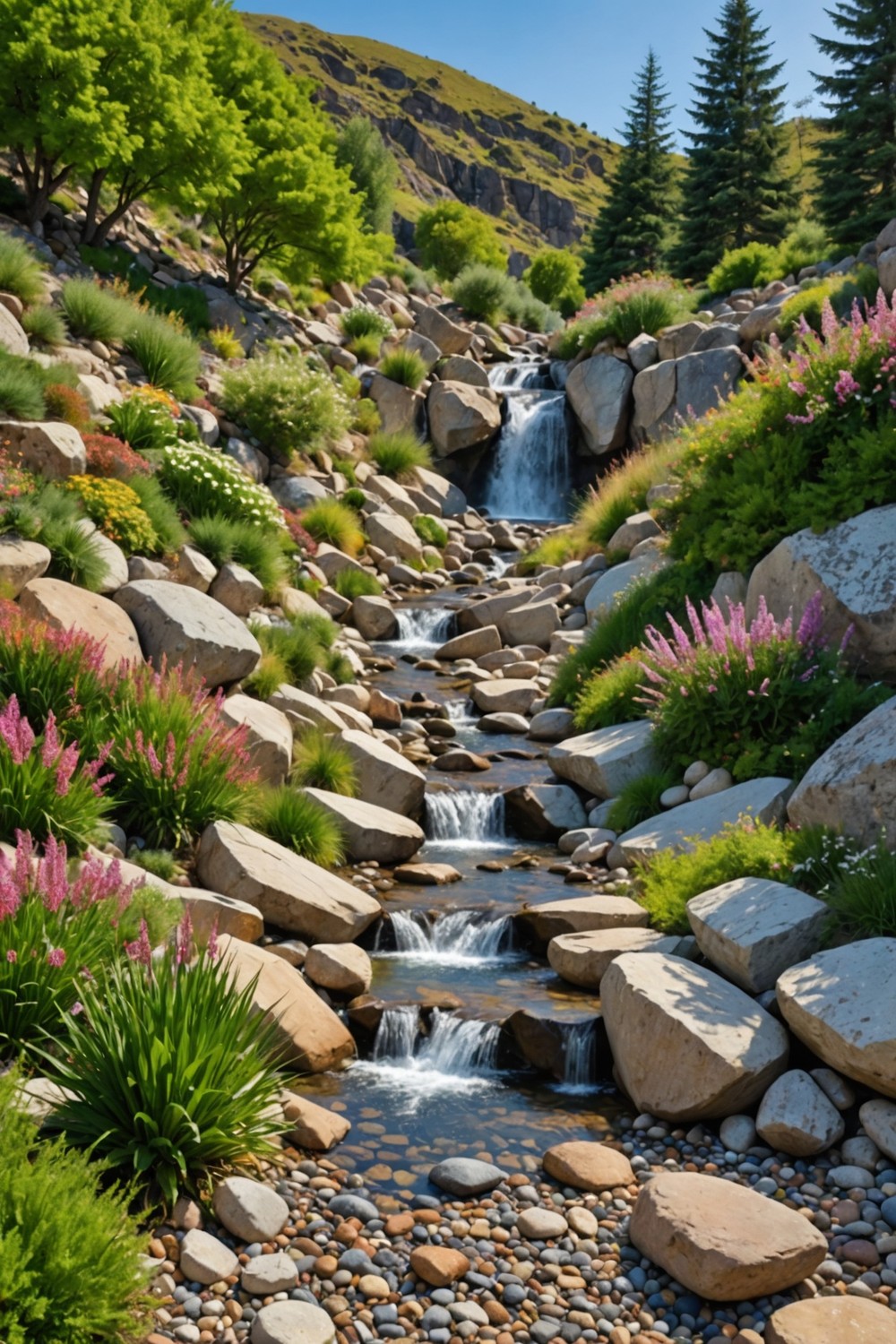
Decorative rock and gravel are great options for hillside landscaping as they provide excellent erosion control and require minimal maintenance.
These materials also allow for good drainage, which is essential for preventing waterlogged soil and reducing the risk of landslides.
Plus, they come in a variety of colors and textures, adding visual appeal to your landscape.
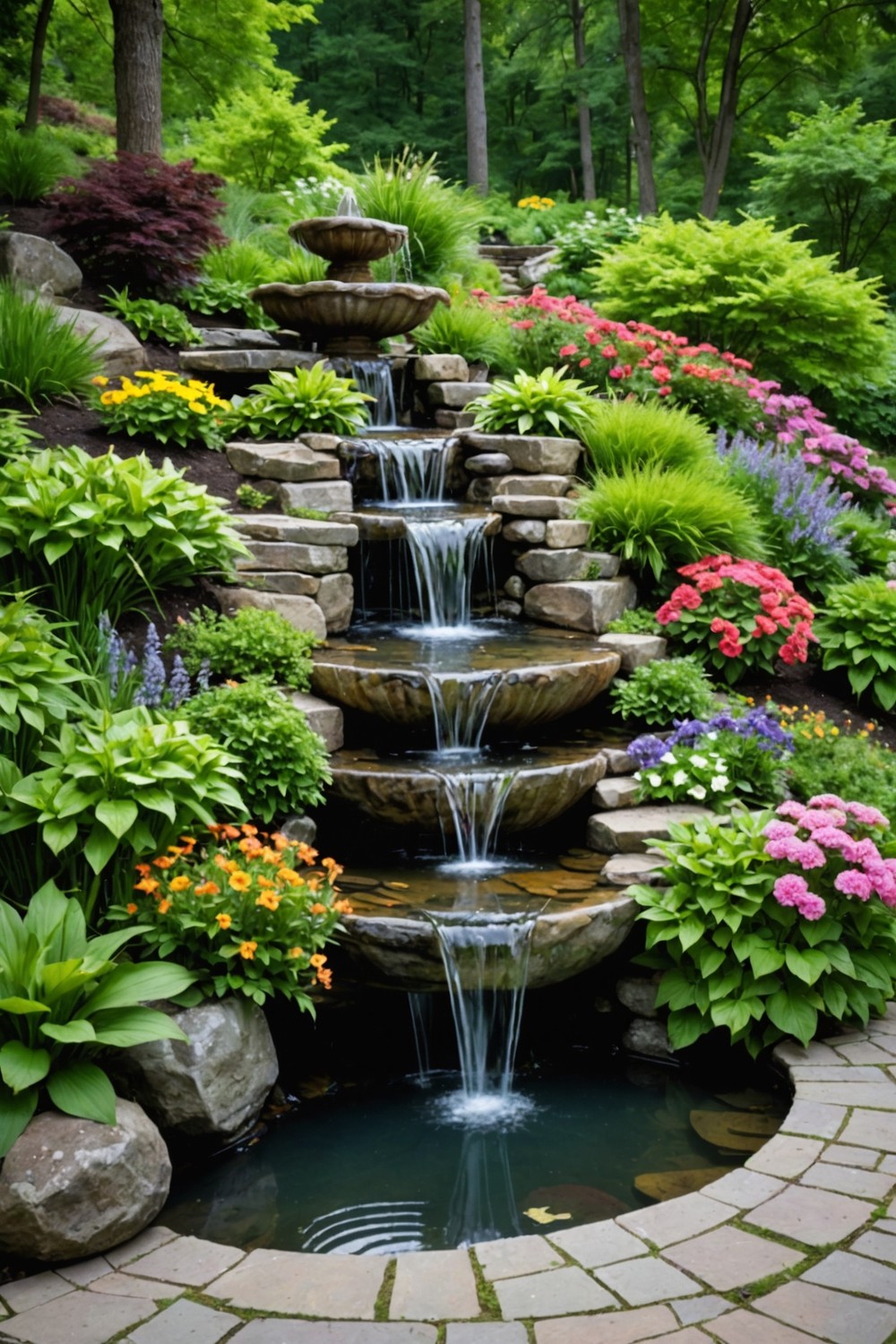
A hillside water feature can add a mesmerizing visual element to your landscape.
The gentle sound of trickling water can create a sense of serenity, while the movement and reflections add depth and visual interest.
Consider a small pond or fountain at the top of the hill, allowing water to cascade down the slope, creating a beautiful display of sight and sound.
This can also help to break up the slope, creating tiered planting areas and adding texture to the landscape.
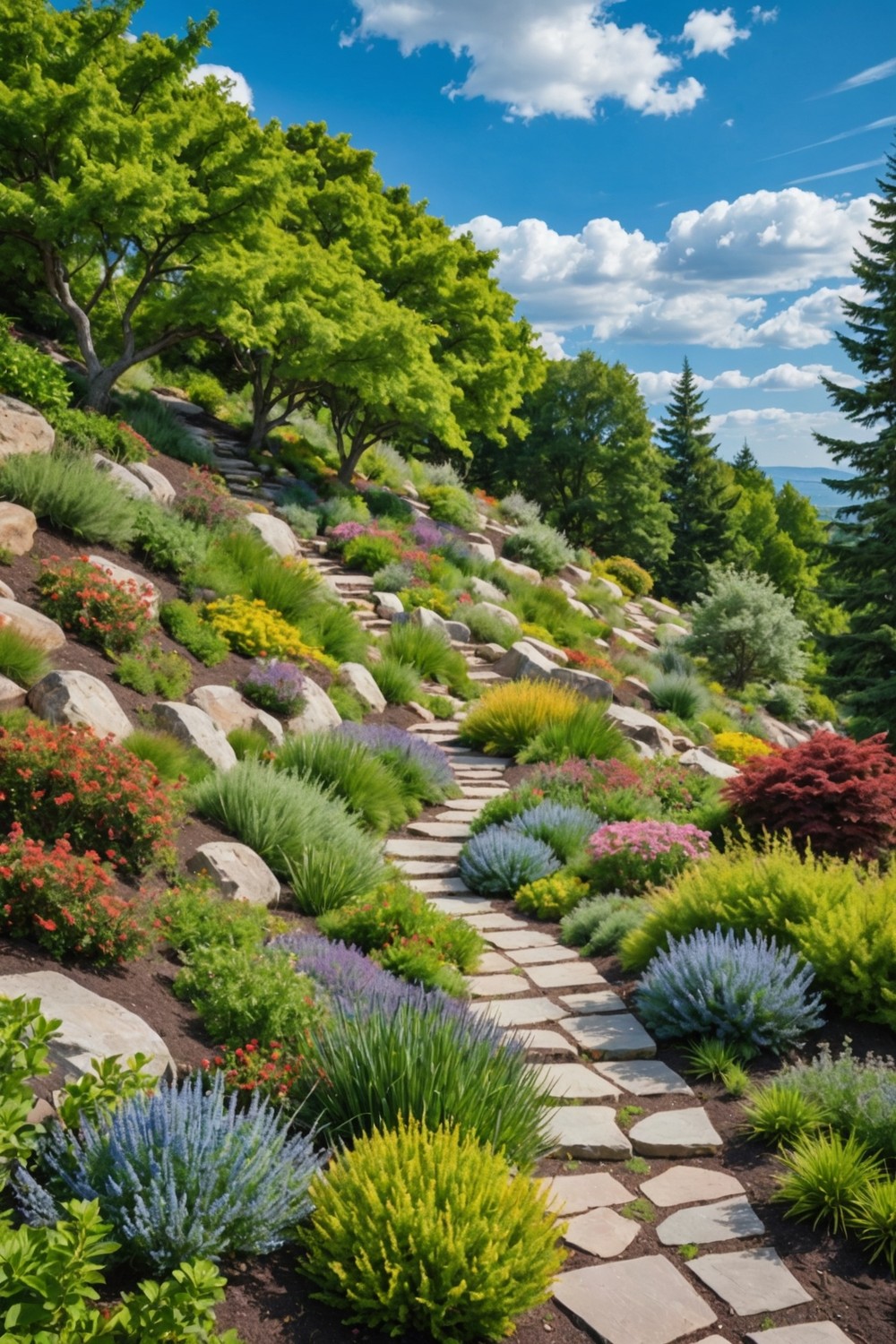
Native plants are the way to go for a low-maintenance hillside landscape. They’ve adapted to the local climate and soil conditions over time, so they require less water, pruning, and fertilization.
Plus, they’re naturally resistant to pests and diseases, reducing the need for pesticides and fungicides.
This means you’ll spend less time and money on upkeep, and more time enjoying your beautiful outdoor space.
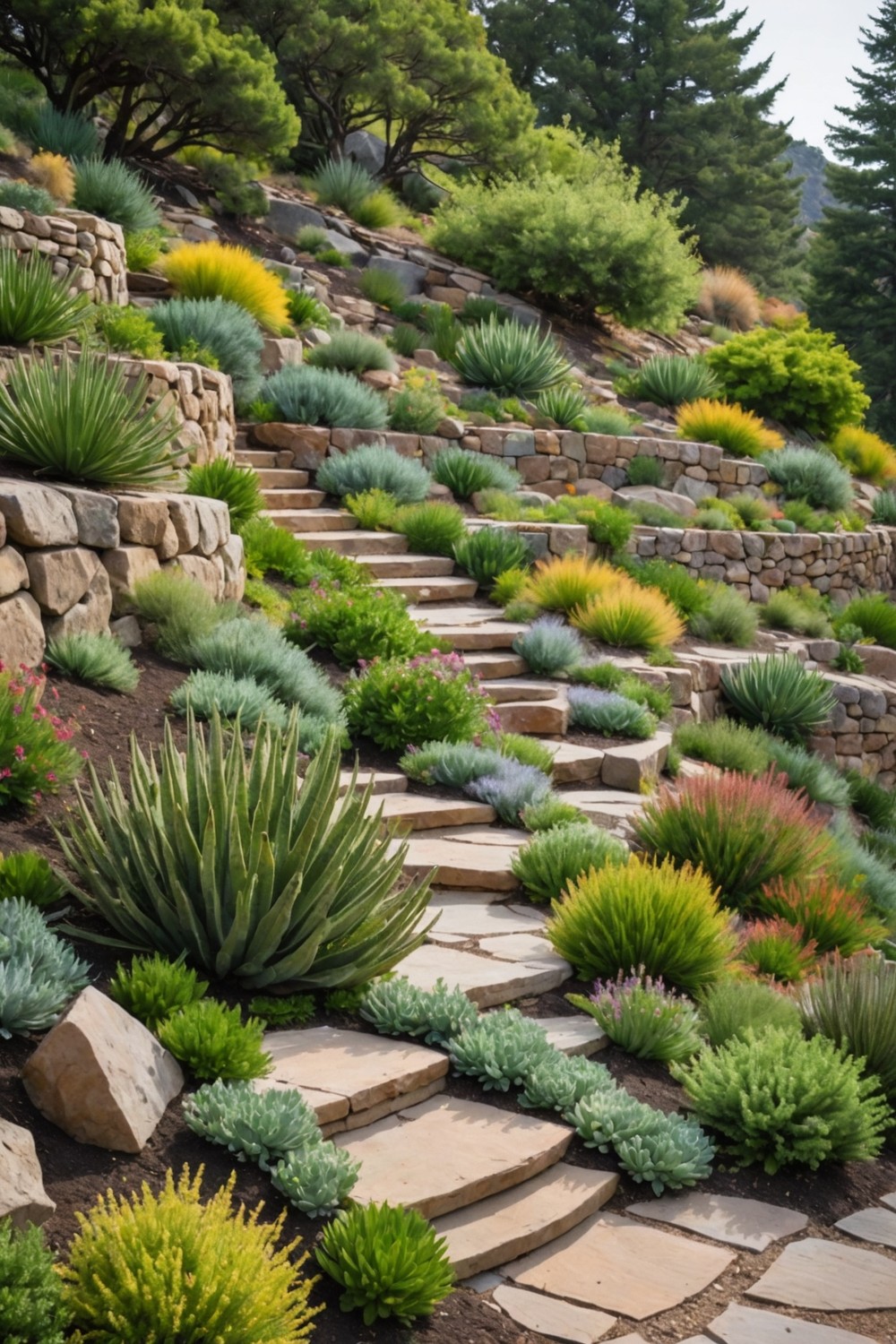
Terracing with native plants and succulents is an excellent option for erosion-resistant hillside lawn alternatives.
These plants have deep roots that hold soil in place and require minimal maintenance.
Another alternative is to use groundcovers like thyme or creeping juniper, which spread quickly and provide excellent coverage.
You can also consider using erosion-control blankets or mats, which help to stabilize the soil and prevent erosion.
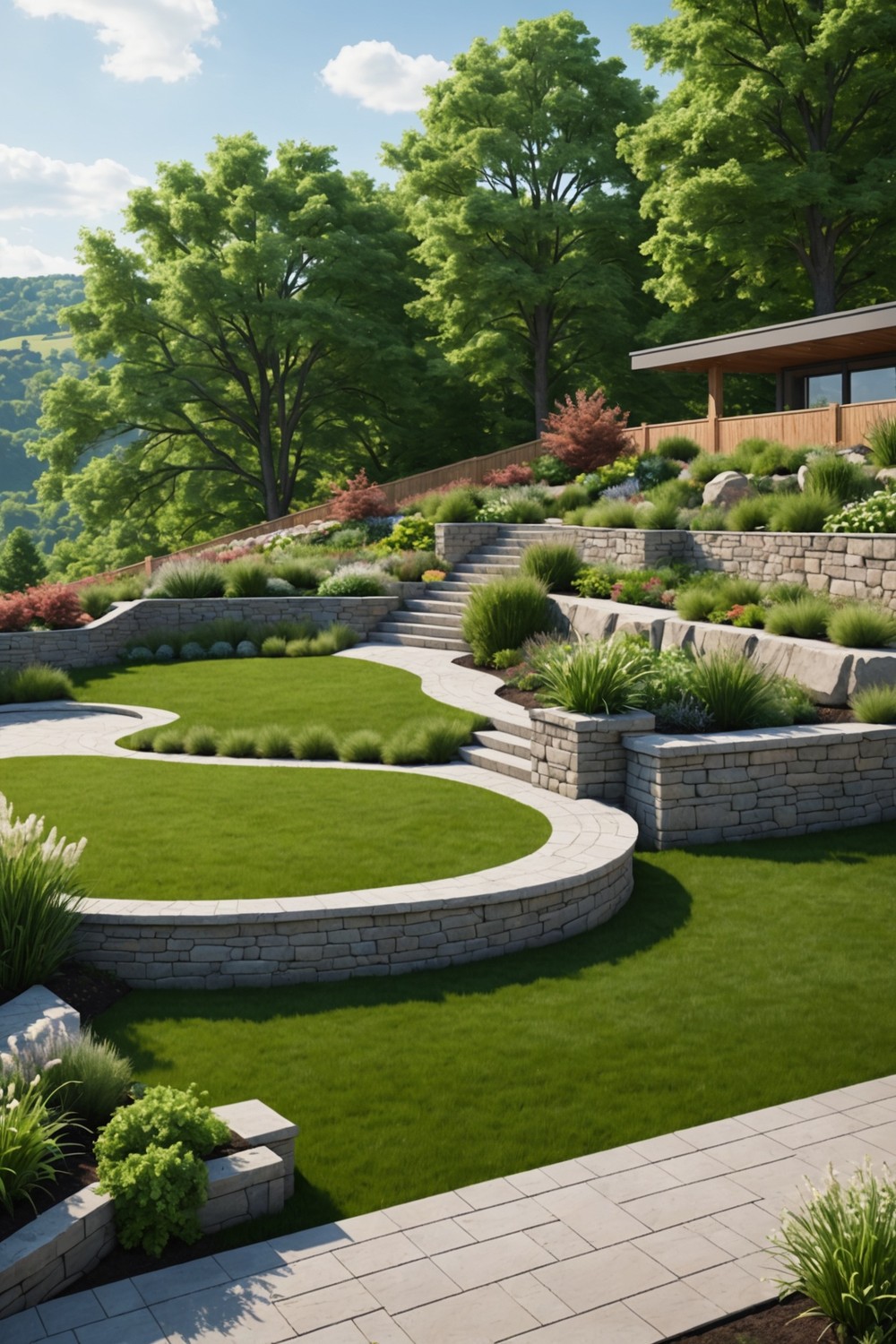
L-Shaped retaining walls are an excellent solution for hillside landscaping as they provide exceptional stability and support to the soil. By creating a 90-degree angle, these walls can counteract the pressure of the soil and prevent erosion.
They also enable the creation of flat areas for gardens, patios, or walking paths, making the most of the available land.
Additionally, L-Shaped walls can be designed to incorporate seating areas, planters, or other decorative elements, adding aesthetic value to the landscape.
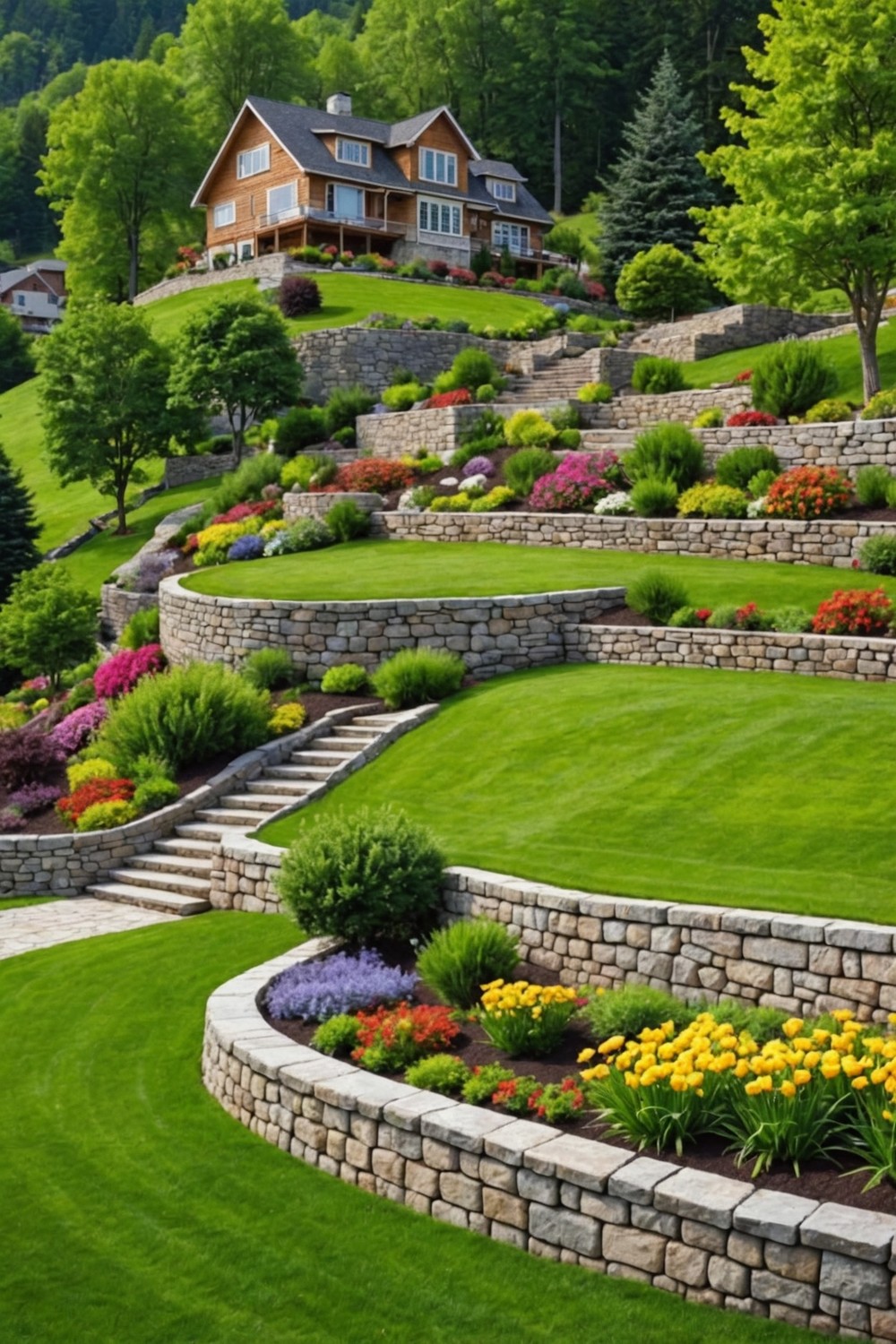
Hillside terracing is an effective way to level your yard and create usable space on a sloping landscape.
By building a series of flat platforms, or terraces, you can create a functional outdoor area that’s perfect for gardening, entertaining, or simply enjoying the view.
This approach not only levels out the yard but also helps to control erosion and prevent soil runoff.
With carefully planned terracing, you can transform a difficult hillside into a beautiful, functional outdoor space that complements your home.
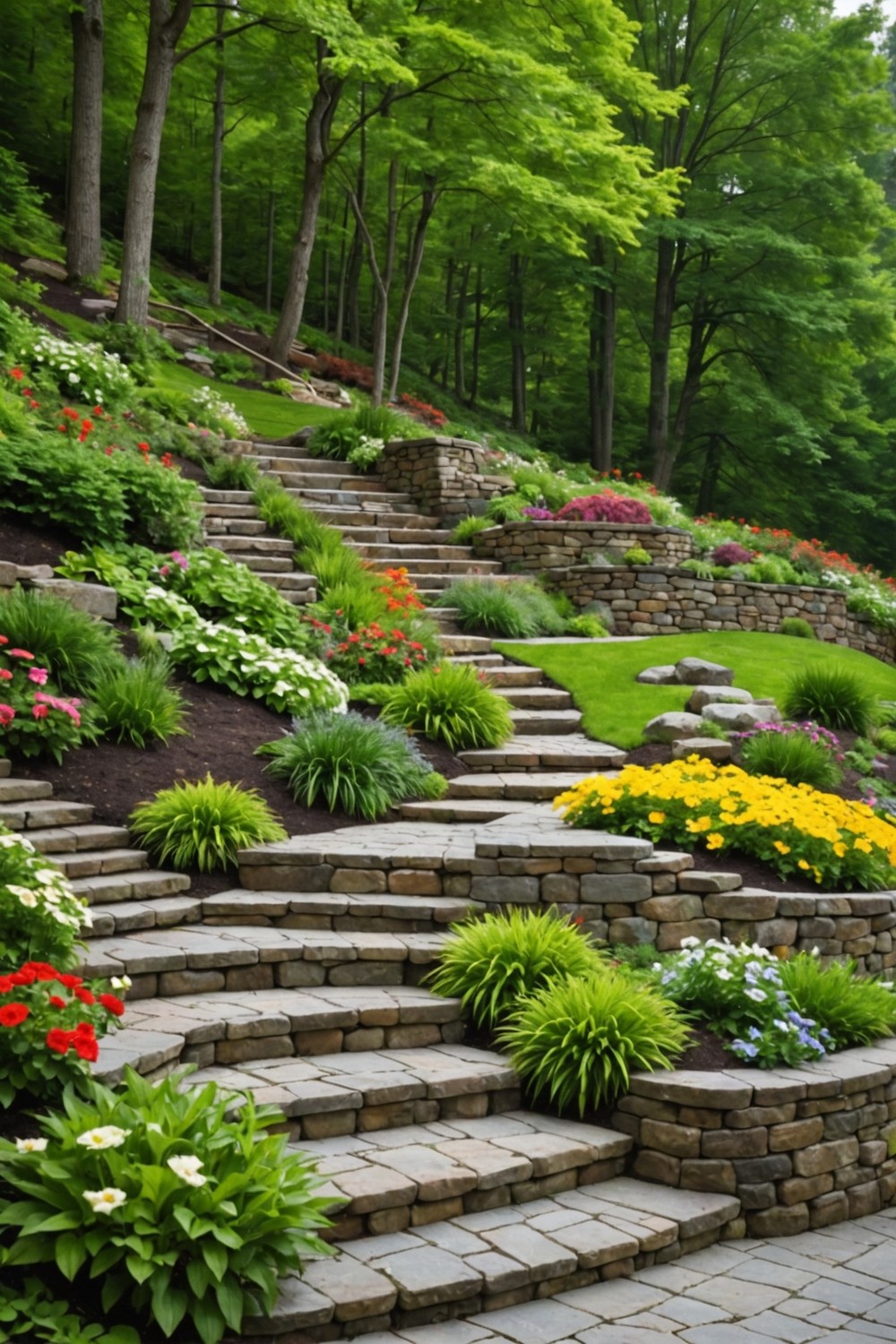
Building a hillside patio or deck requires careful planning and design to ensure stability and safety.
The key is to create a level surface by building up the lower side of the slope with retaining walls or terracing, and then constructing the patio or deck on top.
This will not only provide a flat surface but also help to prevent erosion and create a visually appealing outdoor space.
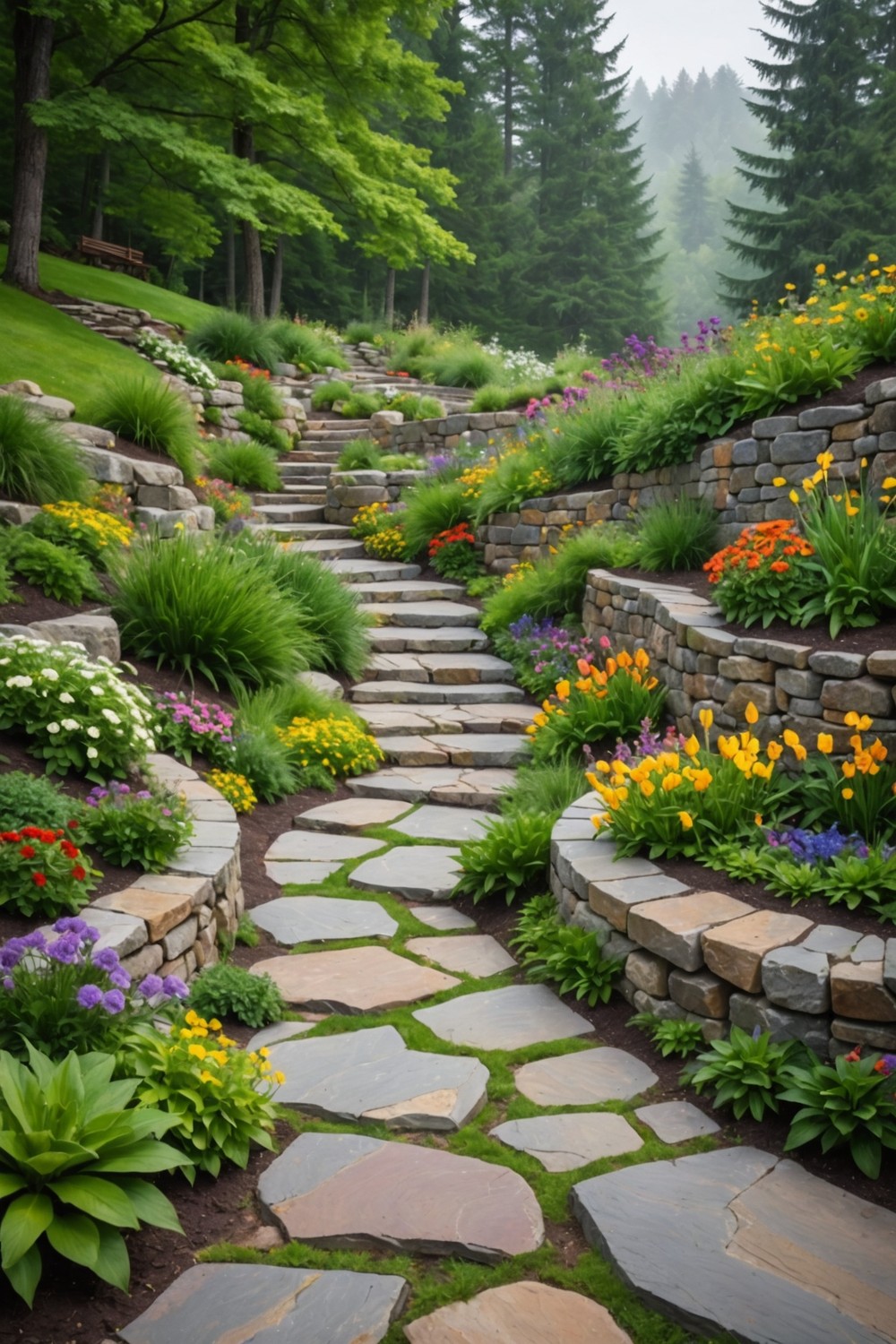
Natural stone is a versatile and durable material that can enhance the aesthetic appeal of your hillside landscape.
By incorporating natural stone into your design, you can create beautiful retaining walls, patios, and walkways that blend seamlessly with the surrounding environment.
Natural stone’s rustic charm and varied textures add depth and visual interest to your outdoor space, while its durability ensures it can withstand the unique challenges of hillside landscaping.
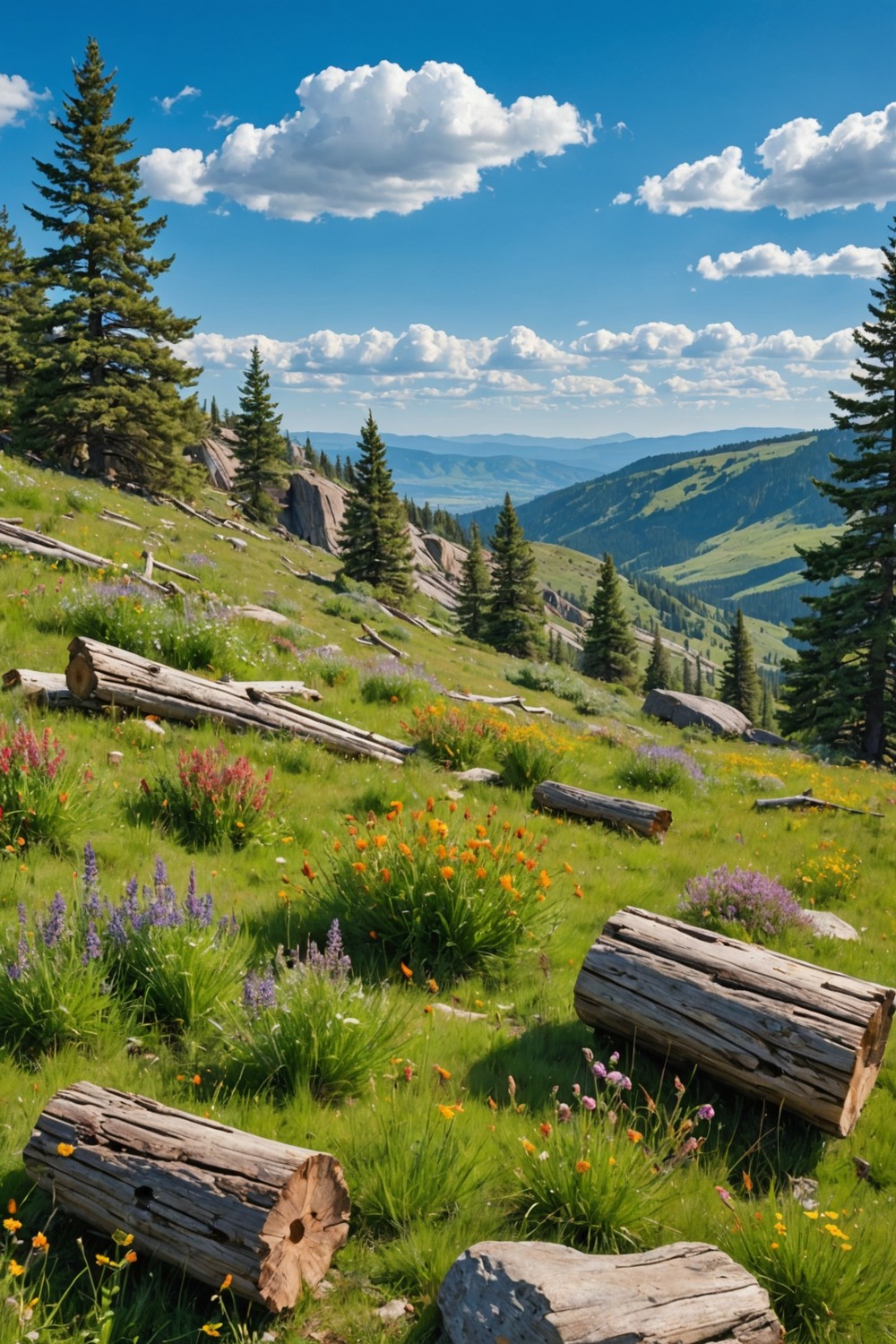
A hillside meadow is an attractive and beneficial addition to your landscape, providing a haven for local wildlife.
To create one, start by selecting native wildflowers, grasses, and shrubs that thrive in your region’s climate and soil conditions.
Next, prepare the site by removing weeds, debris, and existing vegetation.
Then, sow a mix of native seeds, and consider incorporating rocks, logs, or brush piles to create hiding spots and perches for wildlife.
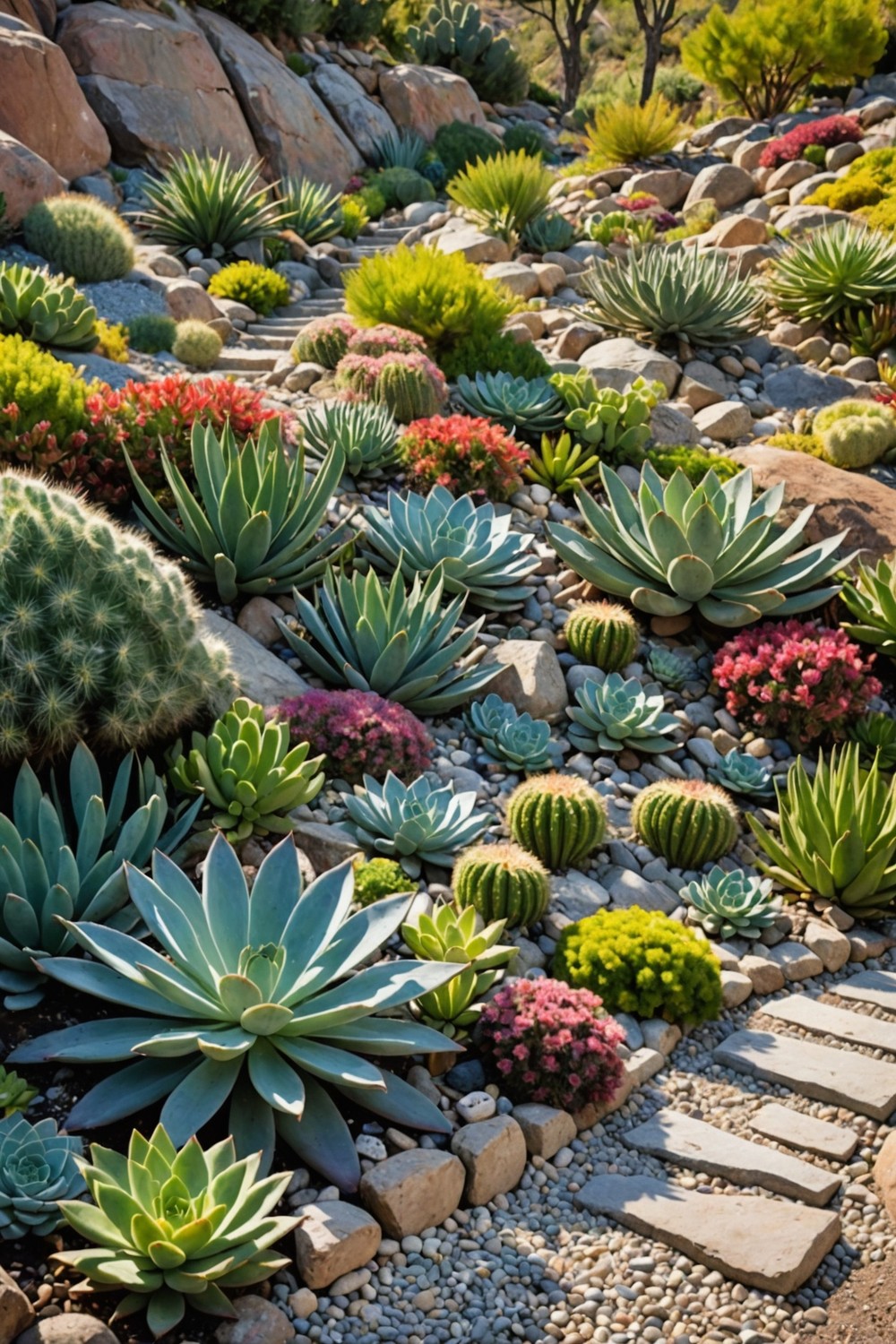
Hillside Landscaping with Succulents and Cacti Hillside landscaping with succulents and cacti is an excellent choice because these plants thrive in well-drained soil and full sun, making them perfect for slopes. They also require minimal maintenance and watering, which is ideal for hard-to-reach areas.
By using a mix of textures, sizes, and colors, you can create a visually appealing and low-maintenance landscape that will thrive in challenging conditions.
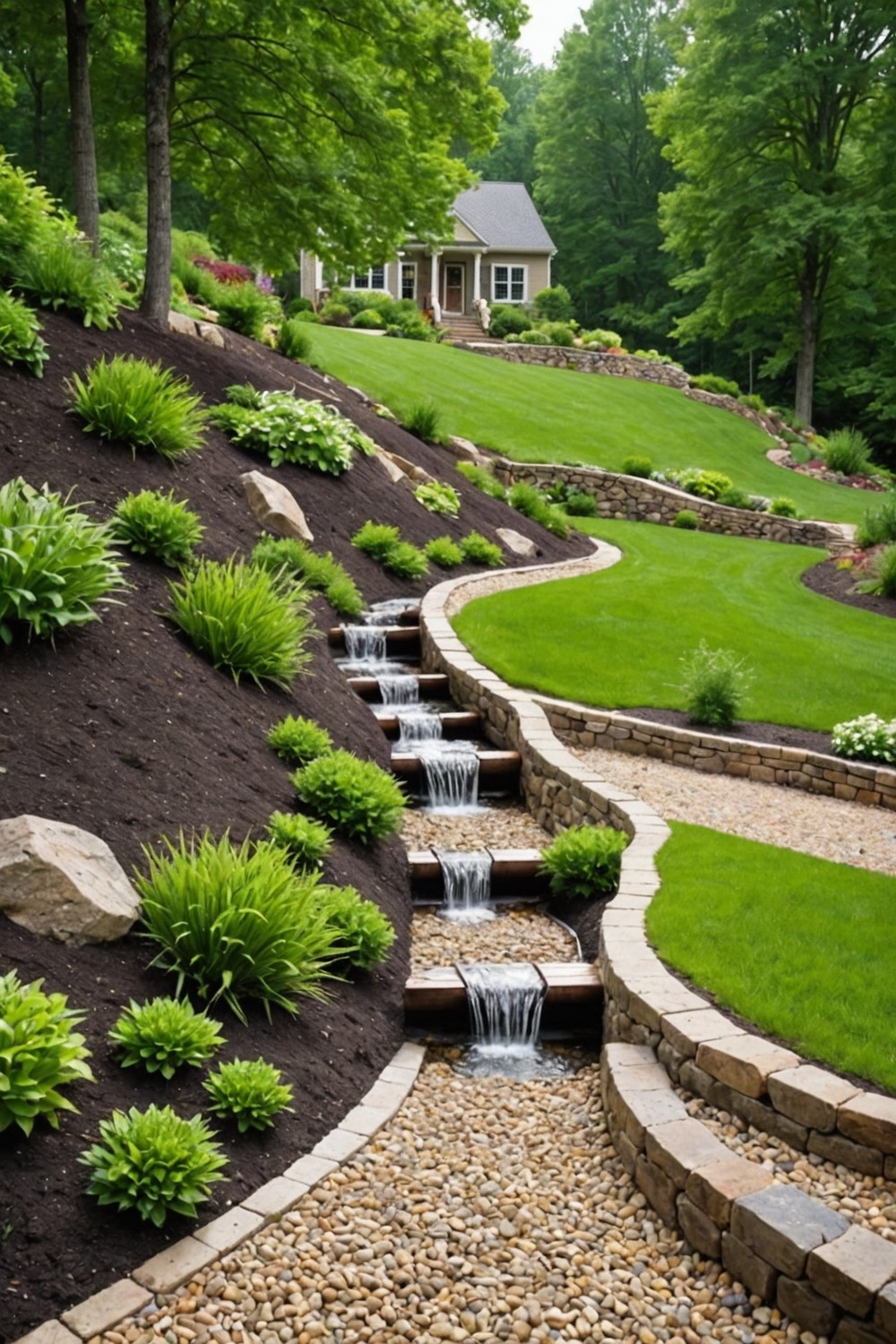
Proper drainage is essential for hillside landscaping to prevent water accumulation, erosion, and structural damage.
A well-designed drainage system includes features like French drains, which involve a trench filled with gravel and a perforated pipe that redirects water away from the hillside.
Another option is a swale, a shallow ditch that captures and filters rainwater, allowing it to slowly infiltrate the soil.
By incorporating these systems, you can ensure a safe and stable landscape that thrives despite the challenges of gravity and water flow.
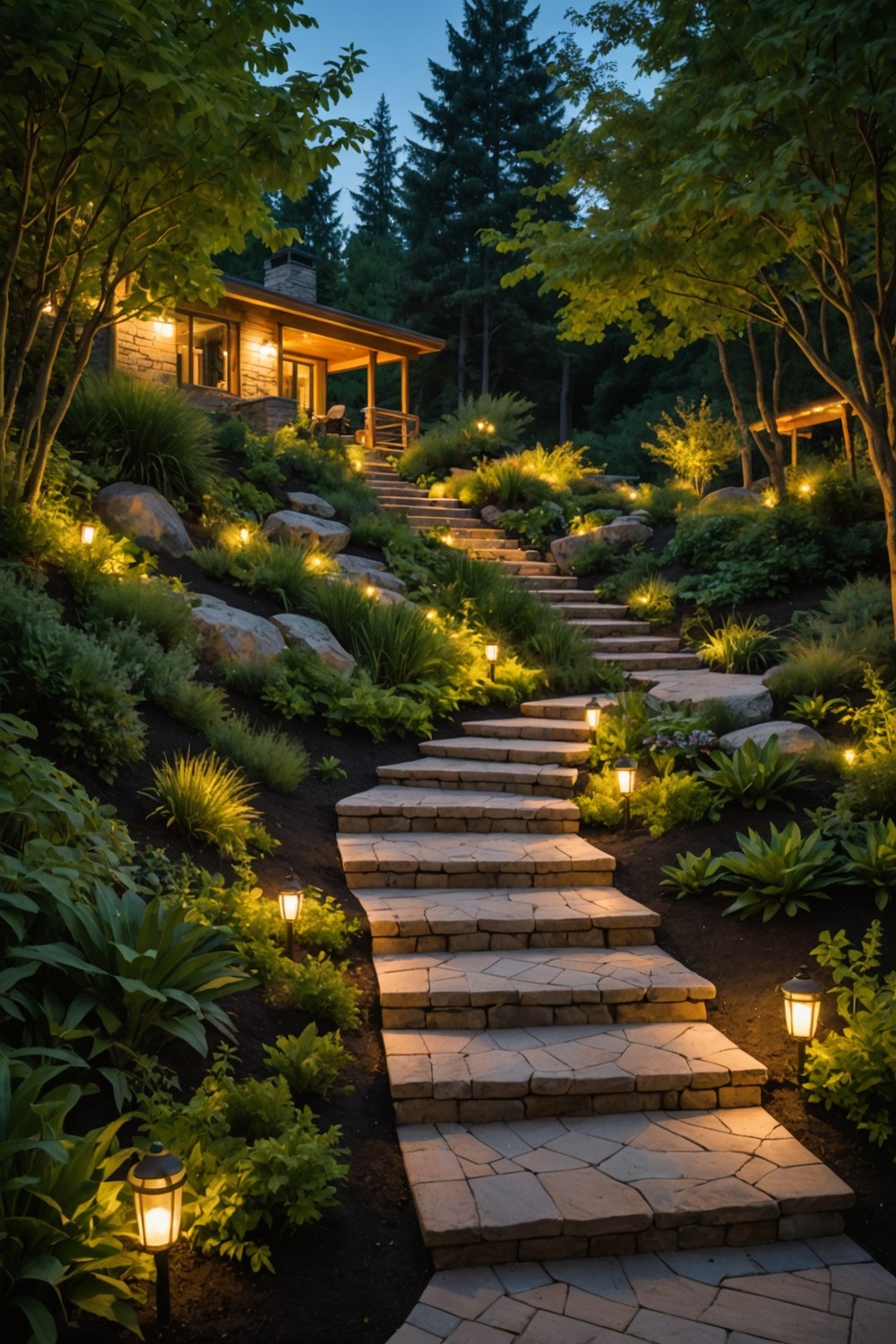
Hillside lighting serves a dual purpose – it not only enhances the aesthetic appeal of your outdoor space but also ensures safety and security. Strategically placed lights can illuminate pathways, stairs, and other areas prone to tripping or falling, reducing the risk of accidents.
Additionally, soft ambient lighting can accentuate the natural beauty of your hillside landscape, creating a warm and inviting atmosphere perfect for evening gatherings or quiet relaxation.
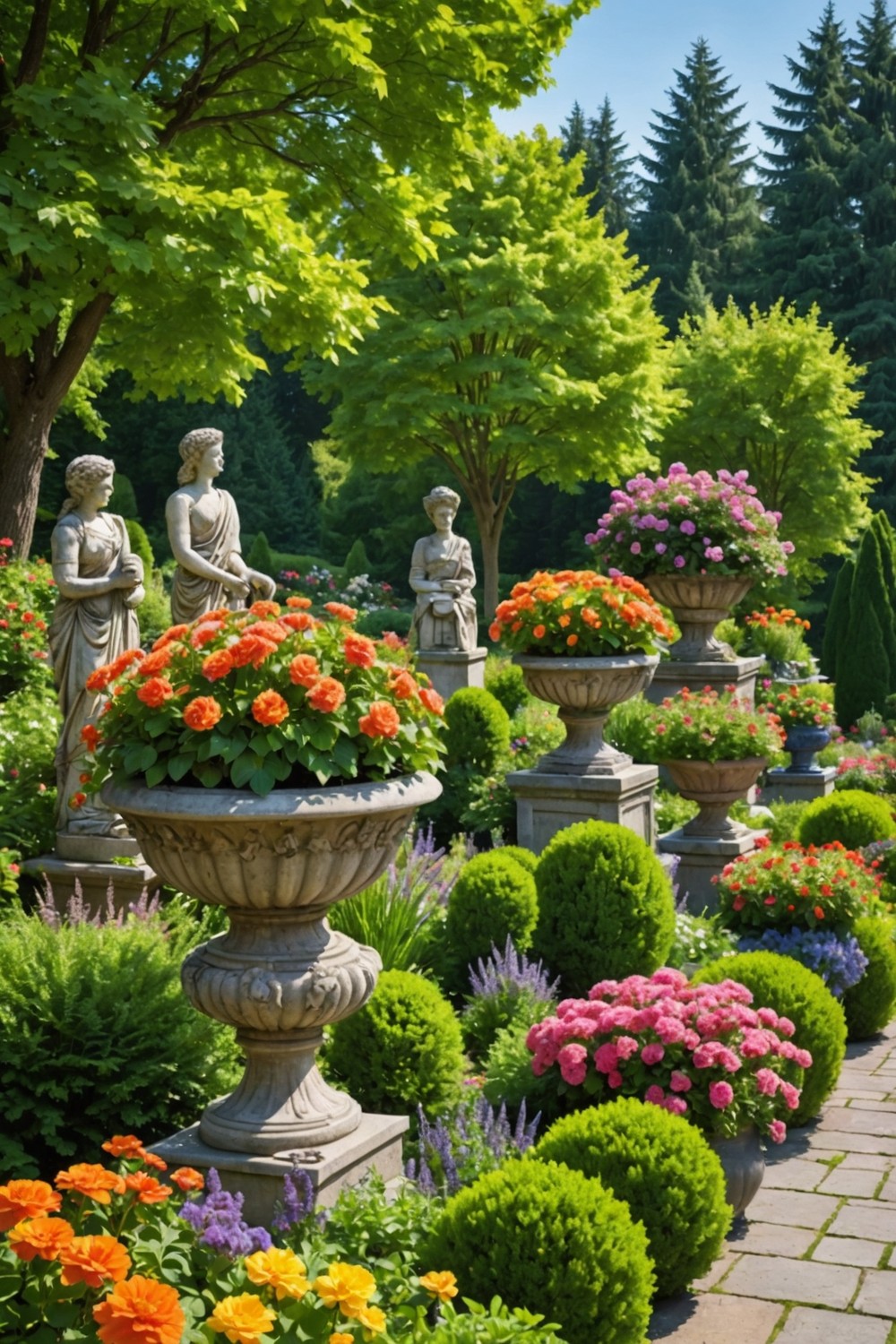
Hillside planters and container gardens are a great way to add some color and depth to your sloping yard.
By using planters and containers, you can create a beautiful garden without having to deal with the challenges of planting directly into the hillside.
Plus, they’re portable, so you can easily move them around to find the perfect spot.
Consider using a mix of planters in different sizes and textures to add visual interest, and don’t be afraid to incorporate a few statement pieces, like a large urn or a decorative statue.
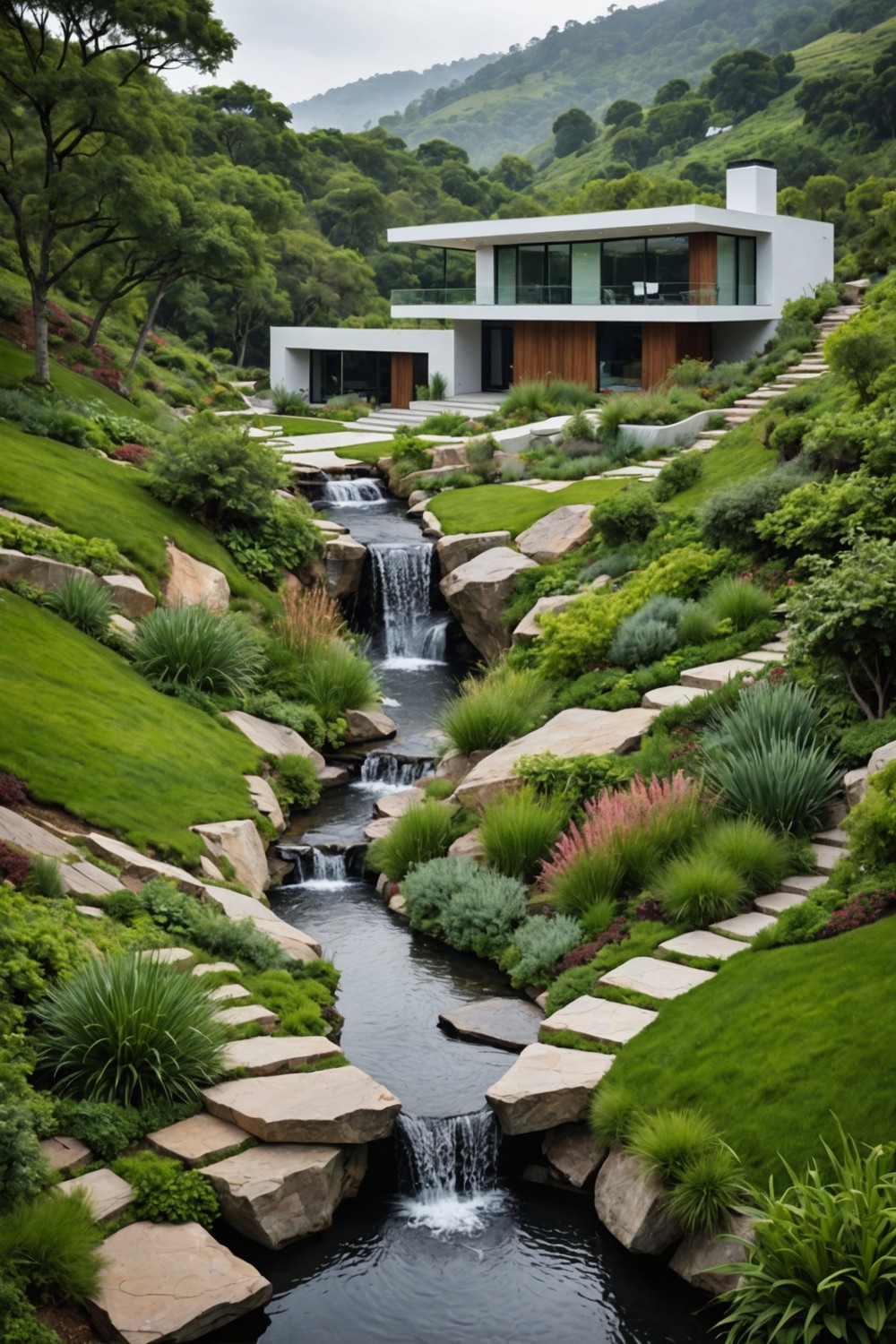
Rainwater harvesting systems are a fantastic solution for hillside landscaping. These systems collect and store rainwater from rooftops and paved areas, reducing the amount of stormwater runoff that can erode hillsides and cause landslides.
By installing a rainwater harvesting system, you can conserve water, reduce your water bill, and create a sustainable landscape.
Plus, the collected rainwater can be used to irrigate plants, wash cars, and even flush toilets, making it a practical and environmentally friendly option for hillside homes.
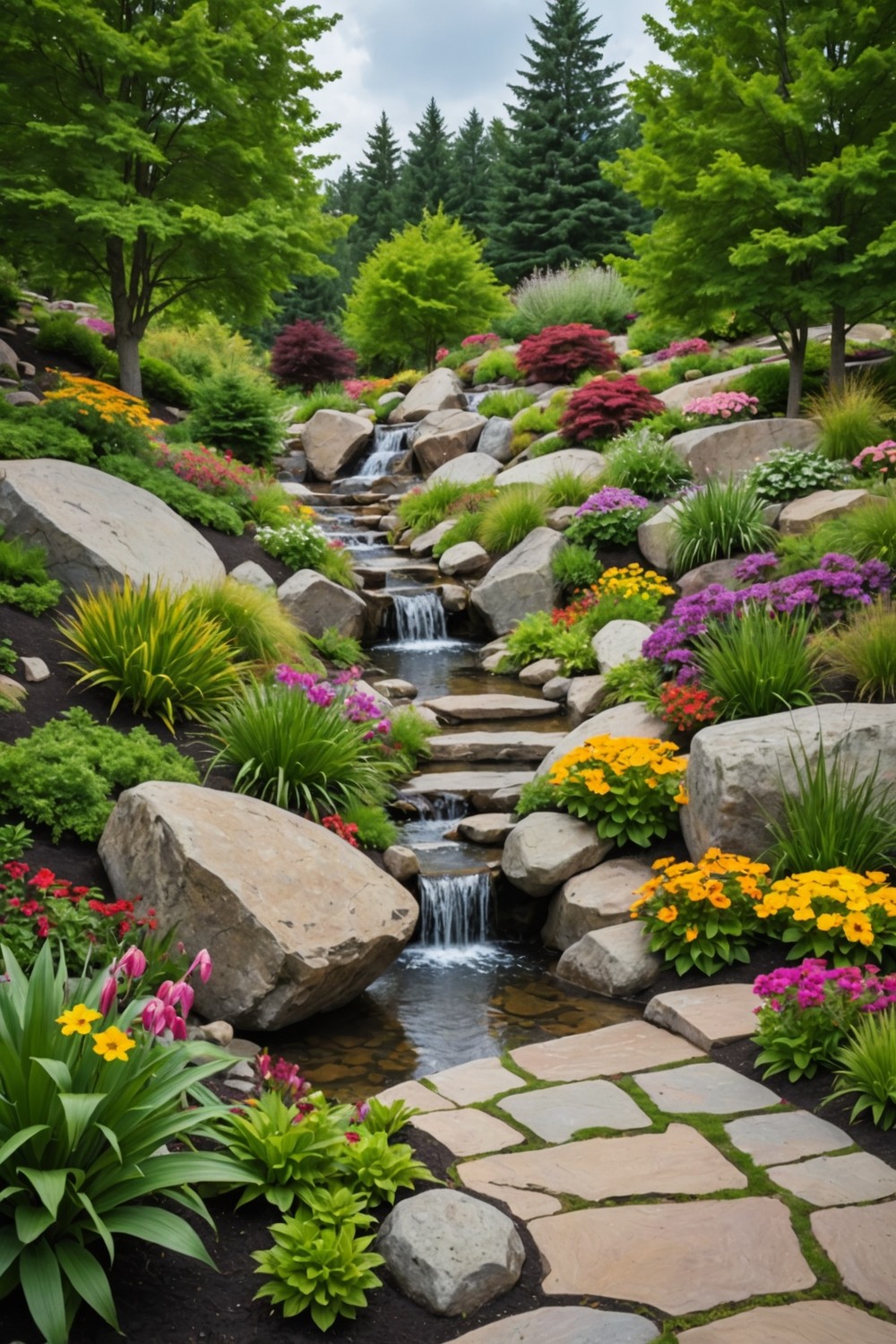
Hillside landscaping with focal points and accents is all about drawing the eye to specific areas of the yard to create visual interest.
This can be achieved by incorporating statement pieces like large boulders, sculptures, or water features that become the main attraction.
Accent plants with bold foliage or vibrant flowers can also be used to add pops of color and texture.
By strategically placing these elements throughout the hillside, you can create a sense of journey and discovery, leading visitors through the landscape.
